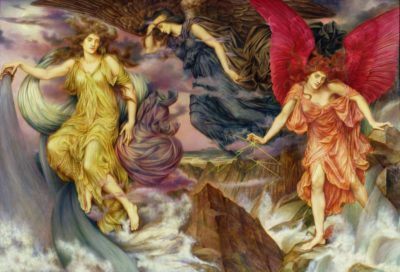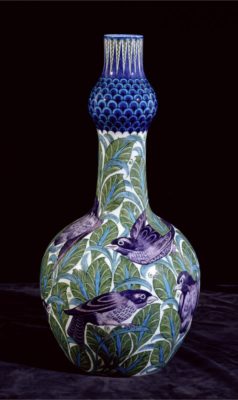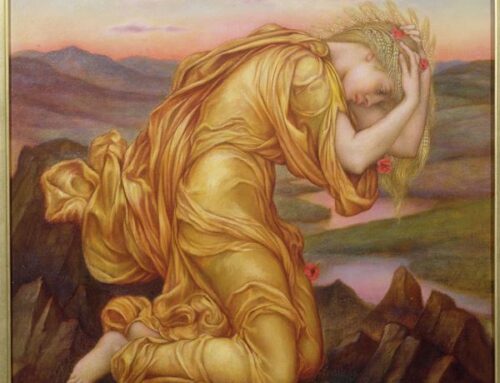The Presence and the Dream: A Decade of the Pre-Raphaelite Society Poetry Prize. Edited by Serena Trowbridge and Sarah Doyle. Review by Glenda Youde.
In The Presence and the Dream Serena and Sarah have collected together a selection of their favourite prize-winning poems to celebrate ten years of the Pre-Raphaelite Society Poetry Prize, augmented with some of Sarah’s commissioned work from the same decade. The thirty-two poems are arranged in chronological order, beginning with Sarah’s ‘Reflections of Ophelia’, winner of the inaugural competition in 2011.
The Poetry Prize was launched to inspire new poetry reflecting all aspects of the lives and work of the wider Pre-Raphaelite circle, as well as encouraging further interest in the Movement. One condition of entry required poets to submit a short paragraph explaining their choice of subject, inspiration, and personal reflection with their poem. These explanations are included at the end of the anthology, adding a greater depth of understanding for the reader. While all aspects of the Pre-Raphaelite movement are included in this collection of ekphrastic poems, with intriguing titles such as ‘Threads’, ‘The Rose of May’ and ‘This Serviceable Ghost’, my review will focus on those poems with a particular relevance to the De Morgan Foundation.
‘Evelyn and Aurora Triumphans’ by Camellia Stafford (2012)
Camellia’s poem identifies Evelyn De Morgan as a professional female artist working on Aurora Triumphans in her Manresa Road studio. The colours and feeling of the painting are evoked in the poet’s choice of vocabulary. Musical imagery abounds: the angels’ wings which dominate the painting become ‘operatic scarlet’, while ‘Falsetto hues of carmine’ and ‘Carnelian tones / whisper on feathers’. In a few well-chosen words the painting’s mis-attribution to Edward Burne-Jones is acknowledged. Notably, Evelyn De Morgan’s personal search for calm and tranquillity in the darkness of war is echoed in both poem and painting as dawn triumphs over night.

‘The Storm Spirits’ by Sarah Doyle (2012)
Inspired by Evelyn De Morgan’s painting of the same name, Sarah’s poem seems to suggest a competition between the three ‘spirit’ elements of a storm – rain, thunder and lightning – to determine who should be crowned the strongest. Each element is represented by a verse, with a unifying couplet reminding the reader that they are ‘A trinity, but each unique’. This theme is drawn together in the final verse where all three work together in harmony that they create the perfect storm, ‘a violent son et lumière’.

‘William De Morgan’s Blackbird Bottle’ by Sarah Doyle (2013)
This unusual poem, known as a ‘concrete poem’, uses visual imagery to illustrate the subject of the poem, as well as describing the object in blank verse. The ‘elegant / neck’ and the way the vase ‘curves / fleetingly / outwards…’ echo the shape of William De Morgan’s bottle as the reader moves their eyes down the page to scan the words. Sarah also references the skill of the potter who ‘coaxed the wet clay’ to form the bottle in the same way that she has shaped it with her words.
‘And Mary went with haste to Elizabeth’ by Ellora Sutton (2020)
(after The Salutation by Evelyn De Morgan)
Taking the voice of the Virgin Mary, Ellora’s poem embodies the human story of the wonder and disbelief Mary surely felt on hearing that she was to bear the Christ Child. Evelyn De Morgan’s painting shows Mary visiting Elizabeth, reaching out to her with bare arms and staring into her cousin’s face, learning that she too is pregnant. Ellora echoes the artist’s emphasis on the physical contact between the two women with her lines ‘neck / shoulder / elbow’ and ‘fingers / nose / eyes’. Her words ‘’forgive me for touching / but nowadays I have to check’ clearly express Mary’s inner emotions and incredulity that she is the chosen one. The lilies bring the traditional iconography representing the purity of the Virgin to both the painting and the poem.
The editors’ selection from the past ten years has produced a stimulating collection which I enjoyed immensely. It is interesting to note that there are many female poets included in the collection, perhaps reflecting the success of the Pre-Raphaelite ‘Sisters’ who excelled in poetry like Christina Rossetti and Evelyn De Morgan herself. Any Pre-Raphaelite enthusiast will be both surprised and delighted by the diversity of verse by the twenty-first century poets who have been inspired by the work of the Brotherhood and their followers, yet the anthology is also a perfect introduction to the subject for newcomers.
The Presence and the Dream is available for £10 inc. p&p by contacting serena.trowbridge@bcu.ac.uk.
Glenda Youde







